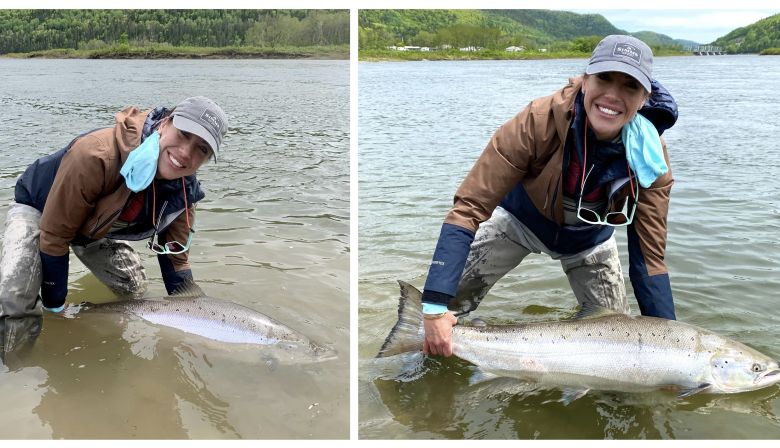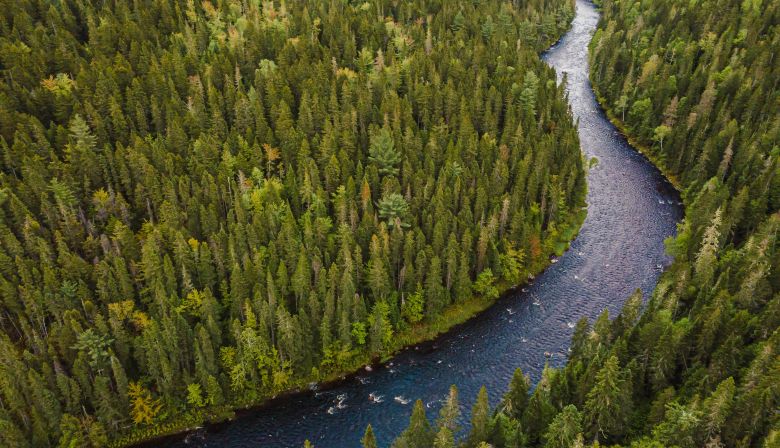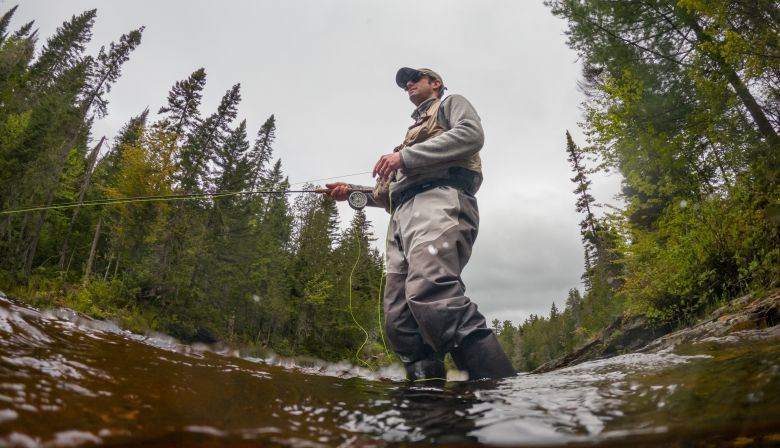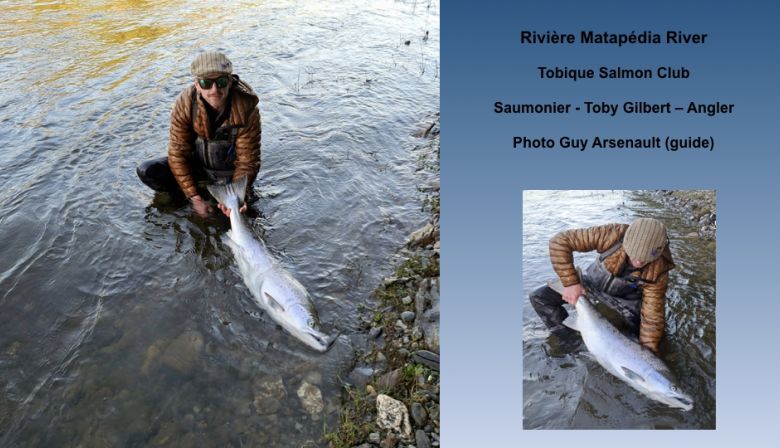
Subscribe & stay up-to-date with ASF


On mainland Nova Scotia, water levels are shockingly low. I recently spoke with ASF’s Regional Director for Wild Salmon Watersheds, Kris Hunter, who expressed concern that while the immediate forecast is good, levels being this low this early does not bode well for the season ahead. The brook near Kris’ home in Antigonish, N.S. has algae throughout that is not typically seen until late summer, and the St. Mary’s River looks as though it’s August.
Throughout Nova Scotia, anglers are sharing similar comments respecting their home rivers. We all remain hopeful that the rain forecast comes later this week, and much more throughout the summer months ahead.
At the same time, Atlantic salmon are appearing in exciting numbers in some places. In Maine, the Penobscot is showing strong early returns, often an indicator of how the year will turn out in Atlantic Canada and Quebec. And angling is off to a strong start in New Brunswick and Quebec, with an impressive number of fish already caught. It’s too early to tell, of course, but signs are good that 2022 could be a stellar year.

Maranda Nemeth, ASF’s Maine Headwaters Project Manager, writes:
Since the Edwards Dam was removed on the Kennebec River in 1999, American shad are now a bit more abundant and ASF staff had good fun fishing for the ‘poor man’s salmon.’ Unfortunately, the shad hit a wall at Lockwood dam in Waterville and struggle to ever locate the entrance to the fishway, so the fish are prevented from moving upstream. It feels like hundreds of shad but their numbers are just a fraction of how many would return if dams didn’t disrupt their migration.
The migratory fish were bountiful below the dam. We saw sturgeon leaping, lamprey in the gravel beds, Blueback herring spawning on the quiet backwaters, striped bass going after alewives along with eagles, ospreys, kingfishers. The stretch of the Kennebec River was alive and active with tons of anglers and boaters, all thanks to dam removal.
DMR’s Jennifer Noll notes:
Lockwood fish lift (mainstem Kennebec) total catches for 2022:
– River herring: 66,669 (stocked only)
– American shad: 0*
– Sea Lamprey: 2*
– Striped Bass: 5*
– Atlantic Salmon: 24
* as of May 30th, reported by Brookfield
Sandy River
Maranda Nemeth continues:
The Sandy River is much below normal flow levels. Flow currently measures at 300 CFS (cubic feet per second) but should be closer to 700 CFS. This is a trend that has persisted the past several years across Maine. Despite the unfavourable conditions, the smolt trap study as reported by DMR’s Jen Noll is showing another promising year of outmigration and sheds light on the highly productive habitat in the Sandy River.
Sebasticook River
DMR’s Jennifer Noll & Nate Gray note:
2.56 million river herring have been counted and passed at Benton Falls dam; the run is rapidly declining. The water temperature is now 20°C. Another Atlantic salmon has passed Benton Falls on May 31st, 2022.
Benton Falls (Sebasticook River) total catches for 2022:
– River herring: 2,560,000
– American shad: 0**
– Atlantic salmon: 3
– Sea Lamprey: 44**
– Striped Bass: 0**
**as of May 25th
Narraguagus River
DMR Fisheries Scientist, Colby Bruchs shared on June 7th:
No new salmon this week. Water temperature steady around 20°C. Discharge remains very low ~150 CFS. American Shad returns have slowed; we have captured 412 to date.
Season total: 2 MSW 0 Grilse.


Penobscot River
DMR Marine Resource Scientist Jason Valliere shared on June 3rd:
River herring are slowing down. Sea lamprey are still tricking in but will be done soon. Shad are coming slow but should still be running for weeks to come. Salmon are still coming strong compared to previous years. Grilse just started showing up. Today we had 18 MSW and 11 grilse (not included in the table below). Total salmon as of this afternoon is 137. River temperature hit 70°F today.

Six days into the recreational salmon season in Newfoundland and Labrador and angler reports are still somewhat slow coming in. Currently, water levels range between medium to high on most rivers throughout the island portion of the province and water temperatures remain cold (<10 degrees Celsius). Anglers have been enjoying success on those rivers where angling conditions are currently more favourable.
Long time SPAWN (Salmon Preservation Association for the Waters of Newfoundland and Labrador) board member, Bob Mercer, reports that he fished three rivers in Bay St. George late last week but didn’t see any fish on two of them. However, he did hook one fish on Fischells River and rose another one. Another angler, Corey LeRiche, reports hooking a grilse on Southwest Brook this past Saturday, and rose another.
Water levels on the Upper Humber are extremely high which for the most part has restricted anglers from fishing. Hence, we are only aware of one report of a large fish being hooked and released on this river to date. Likewise, water levels on most rivers on the Northern Peninsula, such as Portland Creek, Torrent River, and Main Brook, remain very high at the moment, thus restricting angling activity.
The Central Newfoundland region received heavy rain last week and as a result the water level on the Gander increased from low to medium. But to date we have not received any reports of fish being hooked on this river. Likewise, the Terra Nova River received heavy rain and saw a fairly big increase in water levels as well. There are confirmed reports of a few fish moving through the lower Exploits River during the past few days.
Rivers on the South West coast portion of the island, including Grandy’s River and Grey River, did not receive the heavy rain and are currently running a little low. However, there were reports of a few grilse hooked on Grandy’s River late last week. Rivers on the South coast, to the east of Grey River, including the Conne and Garnish Rivers, did receive some heavy rain late last week, and water levels are currently running between medium to high. The Conne River remains closed to all angling currently, due to very low salmon returns in recent years. To date, we are not aware of any salmon being caught on Garnish River so far this season.
The Avalon Peninsula Rivers have fairly decent water flows at the moment, and there have been anecdotal reports of a few grilse being hooked on a couple of rivers in this area. Again, fishing has been a little slow on the Island to date but is expected to pick up over the next couple of weeks.
Also, just a reminder that throughout the angling season in Newfoundland and Labrador this year, anglers can contact DFO’s ‘Angler Line’ at 1-800-782-3058 for resources regarding updates and/or changes throughout the season, regarding river closures and openings, bag limits, etc.
Counting Facilities being installed on schedule:
DFO’s Stock Assessment Division reports that they are on schedule with the installation of their counting facilities on the Island portion of the province this year. To date, they have installed counting facilities on all five rivers that they monitor outgoing smolt counts. These include: Campbellton River, Rocky River, Conner River, Garnish River, and Western Arm Brook. Most adult counting facilities on the Island have already been installed or will be going in on schedule.
In the meantime, due to high water levels in Labrador DFO expects they might be a week late installing counting facilities in this region of the province.
Emily Rodger, a former elite athlete and avid fly fisher, has fished all over the world. The last few years, Emily has connected with some large Atlantics on the Restigouche River. She writes:
For the last 3 years, I have booked a few days to fish at Restigouche River Lodge in the early season. The season that is prime time for when the big, bright, fresh Atlantic salmon start making their way up the river systems. I have been fortunate enough to hook, land, and safely release a 30+ pound salmon each year and this past weekend was no exception.
These are the moments I anticipate. These are the moments I surrender to.
Every fish has a story. As I watch them swim away, I am in awe and always conscious to capture as many emotions as I can. Those feelings usually consist of a disbelief that it has happened, and I must remind myself that, “Yes, yes that DID just happen”.
Keith Vanacore (one of the partners at Restigouche River Lodge) and I were in the boat together on the morning I connected with the fish pictured below. I had my phone out to take a photo when an email popped up. It was a message from a fly fishing magazine asking if I would write a story on Atlantic salmon. I read the email to Keith and jokingly followed with, “now I just need a new salmon to write about.”
I put my phone away and picked up my rod. Dropping my fly to the right of the boat, I let it swing. I picked up the fly and dropped it to the left. As soon as my fly touched the water, we heard a loud “swoosh.” I looked down to see the image that matched the sound, and I set the hook. With reel screaming, I said to Keith: “Here is my story.”
To learn more about Emily, visit her website and follow her on Instagram.

ASF’s Tom Cheney reports:
I spent a few days this weekend fishing with friends for sea trout on the Miramichi. Action was hit and miss, but we did raise one very large trout and managed to release several in the 1 to 2-pound range. Anglers on the Miramichi have also seen an exciting number of fresh Atlantic salmon so far, with a surprising quantity caught in late May and many more the first weekend of June. Water levels are looking very good and everyone is optimistic for great salmon fishing this season.

ASF’s Frances McCurdy and Heather Perry kicked off Oceans Week by participating in a Shoreline Cleanup event this past Saturday. Frances writes:
In partnership with the Huntsman Marine Science Centre and Ministers Island to celebrate World Oceans Day, Ocean Week Canada and the Debris Free Fundy Initiative, ASF staff spent a rewarding three hours on the beach and collected a whopping 160kg of garbage. Thank you to the volunteers who joined in and made this event a success.
Charles Cusson, Directeur québécois, Fédération du saumon atlantique:
Les informations préliminaires disponibles en provenance des rivières ou la pêche est permise, indique un début de saison du tonnerre.
Les cours d’eau tels la Matapédia, Causapscal, Cascapédia et les rivières York, Dartmouth et Saint-Jean, connaissance des montaisons de gros saumons très encourageante.
Les pêcheurs se réjouissent à date due au niveau d’eau et des débits à la baisse. Des prédictions météorologiques aux endroits stratégiques comme Murdochville et Amqui indiquent des précipitations modestes durant la prochaine semaine.
Cependant, sur la côte nord, les débits demeurent très impressionnants.
La CGRMP indique, en date du 5 juin, sur la Matapédia que 17 grands saumons ont été graciés par rapport à 9 à pareille date en 2021.
Du côté de la Causapscal, 18 saumons graciés et 21 récoltés pour un total de 39. 15 saumons furent récoltés et 19 gracié à la même date en 2021 pour un total de 34.
Au fur et à mesure que les organismes gestionnaires publieront les résultats de la première semaine, je partagerai ces informations avec vous.
Les données utilisées dans ce rapport proviennent de divers sites web, des médias sociaux et de source gouvernementale québécois. Les informations peuvent changer sans avis au préalable en ce qui concerne les comparatifs des saisons précédentes.
Charles Cusson, Director of Quebec Programs, reports:
Early season information indicates a thunderous start to the season. Daily, many large fish are being landed. Reports from rivers such as the Matapédia, Causapscal, Cascapédia and the York, Dartmouth and Saint-Jean rivers are very encouraging.
Currently, anglers are rejoicing in the fact that levels and flows have dropped dramatically since last week. Weather forecasts at strategic locations like Murdochville and Amqui are forecasting modest precipitation over the next week.
On the other hand, on the North Shore rivers the flows remain very impressive. See graphs above. The CGRMP which manages the Matapedia, Patapedia and Causapscal rivers, are reporting as of June 5th that Matapedia anglers have landed and released 17 large salmon compared to 9 at the same date in 2021.
On the Causapscal side, anglers have landed and released 18 large salmon and have harvested 21 for a total of 39. 15 salmon were reported released and 19 harvested to the same date in 2021 for a total of 34.

Marie-Soleil Cyr, outdoor enthusiast and angler, began her season on the Dartmouth River in Gaspé, and shares:
Fly fishing is a beautiful blend of many things.
Four years ago, when I caught my first Atlantic, I was immediately “hooked”. It amazed me to see such a majestic fish and I was impressed by the technicalities of angling for salmon.
But time on the river is not just about catching fish. The river is a powerful place. It gives me peace, joy, fulfillment, excitement and memories that will last a lifetime. But most of all — it makes me feel alive and grounded. I can easily fish fourteen hours a day, just to have the mere chance of connecting with this sacred fish.
This year, on my first day of the season, the river gave me a shiny female after only a few casts. Like every time I have caught a salmon, I remembered that fishing is not simply a sport, it truly is an adventure.

We captured two salmon parr above the Windsor causeway. These would likely be the product of wild fish spawning last fall, as there is no stocking program in the Avon River system. Two parr were caught by Alyssa Palmer-Dixon, Species at Risk Project Lead with The Confederacy of Mainland Mi’kmaq (CMMNS) and Lachlan Riehl, River Monitoring Project Coordinator with CMMNS.
We are working on determining presence/absence of Inner Bay of Fundy (iBoF) salmon on river branches above the Windsor causeway. Now that we have fish passage through Windsor causeway, electrofishing surveys carried out this year will establish a baseline to assess population changes in iBoF Atlantic salmon in the coming years.
Jacques fishes mostly the Miramichi and Restigouche rivers and has been a commercial fly tier for the past 30 years. Throughout the years, he has had salmon flies published in magazines, books and websites, wrote articles and won many fly tying contests. He has published three fly fishing books, two of them on Atlantic salmon flies.
Jacques was inducted into the New Brunswick Atlantic Salmon Hall of Fame in 2009 as a fly tier. In June 2015, he received the Roderick Haig-Brown award from the Canadian Wildlife Federation, and in 2016 the Jean-Guy Côté award—a national award that underlines the work of a Canadian who has contributed their heart and soul to the world of fly tying. In 2019, he was the ASF-NBSC Moncton Dinner Honoree.
Recently retired as Manager of Larry’s Gulch Lodge on the Restigouche River for the past four angling seasons, Jacques is a past Director for the NB Salmon Council. He has been a member of ASF-NBSC Moncton Dinner committee for many years, and of course has played a pivotal role as President of the Dieppe Fly Tying Club.
Jacques has led many initiatives focusing on awareness and education such as the Dieppe Fly Fishing Forum and the Atlantic Salmon Fly International with special attention to bringing youth and newcomers to fly fishing and fly tying.
Email: jacques@salmosalar.info
Website: http://www.salmosalar.info